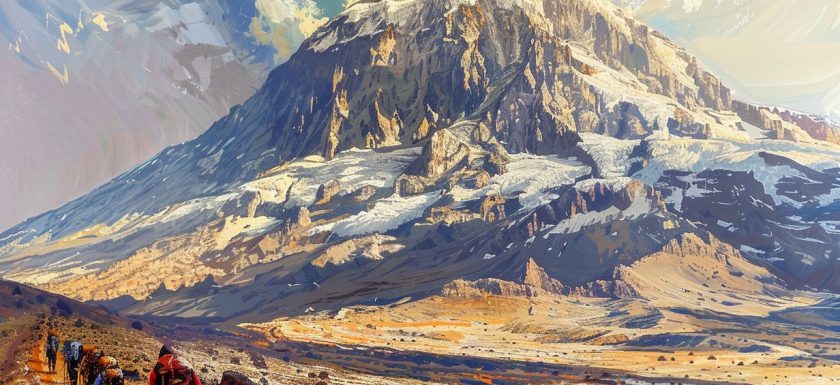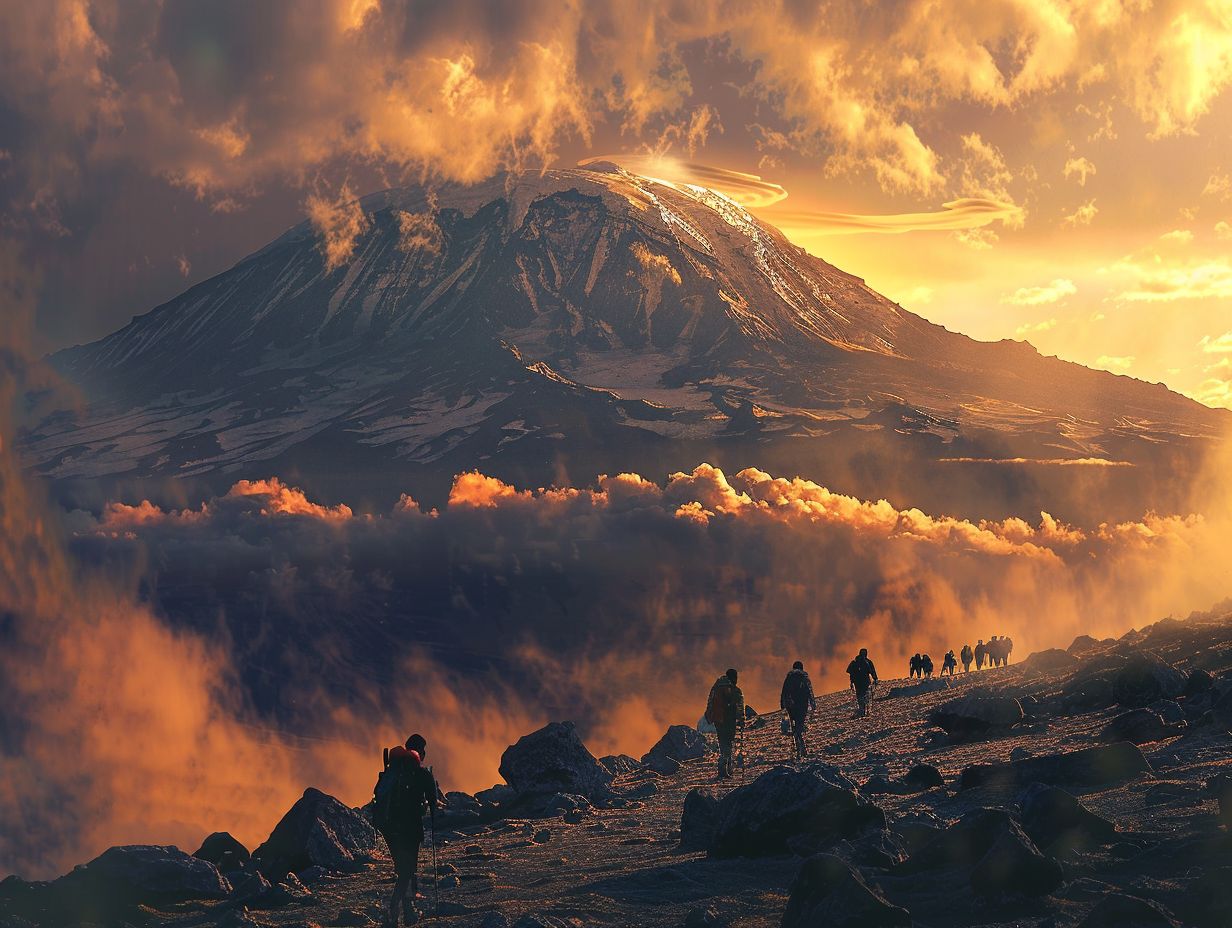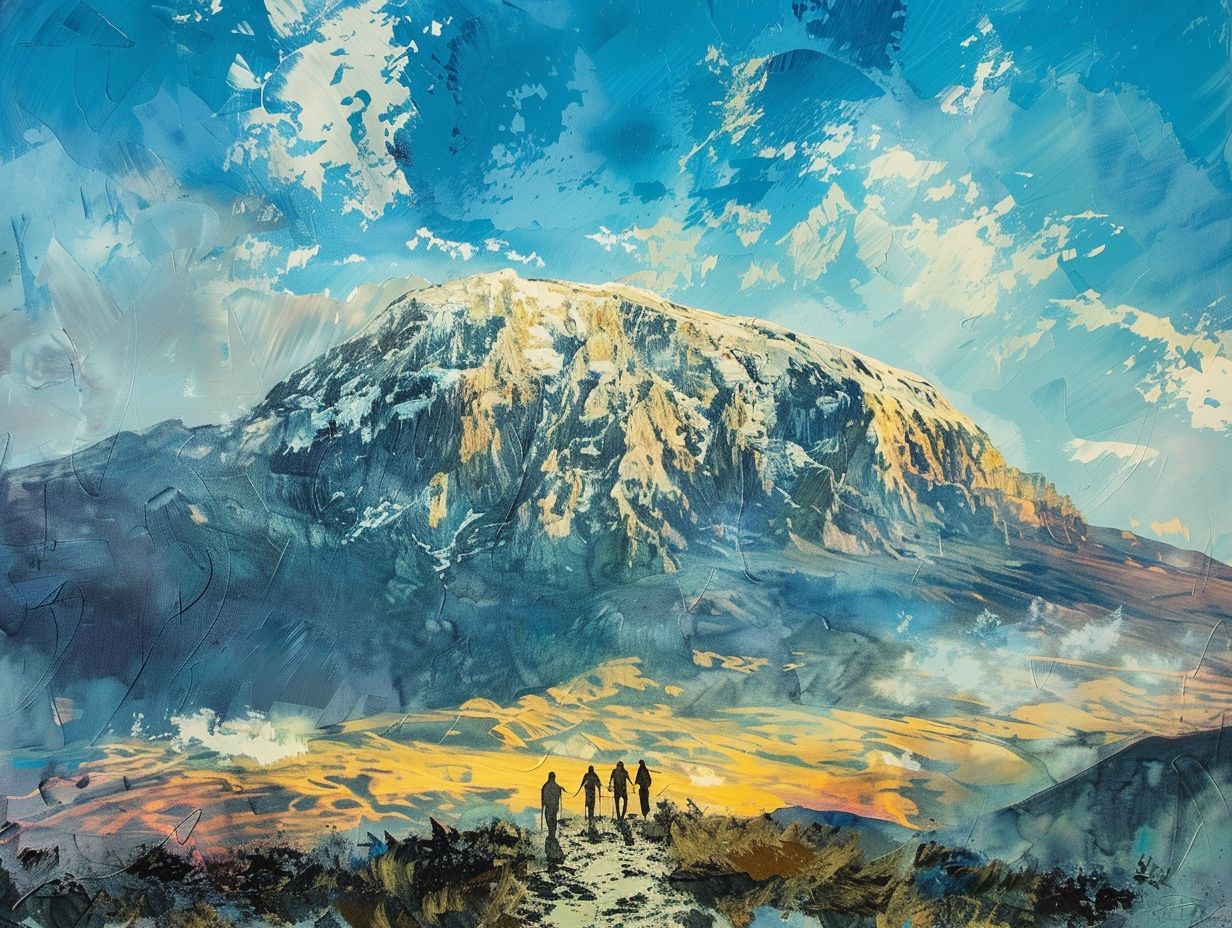
Have you ever dreamt of conquering Africa’s highest peak, Kilimanjaro?
Before embarking on this incredible journey, it’s essential to understand the costs involved.
Explore the main routes to climb the mountain the different types of accommodation available, the best times to embark on this adventure, safety precautions to consider, and the physical requirements needed to tackle this challenging expedition.
Dive into the world of Kilimanjaro and discover what it takes to reach its summit.
Key Takeaways:
- Climbing Kilimanjaro can cost anywhere from $1,000 to $5,000 depending on various factors such as route, group size, and tour company.
- The biggest cost of climbing Kilimanjaro is the park fees and permits, which can range from $50 to $1,500.
- Apart from fees and permits, climbers should also budget for additional costs such as equipment, tips, and travel expenses, which can add up to a significant amount.
Why Do People Climb Kilimanjaro?

People climb Kilimanjaro for various reasons, including the challenge of summiting Africa’s highest peak, the stunning views from the Uhuru Peak, and the sense of accomplishment that comes with conquering such a renowned mountain.
Embarking on a Kilimanjaro expedition is not just about reaching the summit; it’s a journey of self-discovery and pushing personal limits.
The allure of conquering such a formidable peak like Kilimanjaro resonates with the adventurer’s spirit, drawing individuals seeking a transformative experience.
Standing at the summit of Mount Kilimanjaro can evoke profound emotions, prompting climbers to reflect on their perseverance and resilience.
Each step towards the summit is a testament to one’s determination and bravery, instilling a sense of pride that transcends the physical challenges faced during the climb.
What Are The Main Routes To Climb Kilimanjaro?
Kilimanjaro offers climbers a choice of seven main routes, each with its unique characteristics and challenges, such as the popular Marangu and Machame routes or the less-trekked Meru route.
Among these routes, the Marangu route is known as the ‘Coca-Cola’ route due to its relative ease, while the Machame route, often dubbed the ‘Whiskey’ route, is celebrated for its picturesque scenery and diverse landscapes.
On the other hand, the Meru route offers a quieter and more remote experience, with stunning views of Mount Kilimanjaro’s northern face. The Rongai route, originating from the north, is considered one of the easier options, providing a different perspective of the mountain.
Shira and Lemosho routes are known for their varied terrains and panoramic vistas, suitable for those seeking a more challenging ascent amidst breathtaking environments. The Umbwe route, recognized as the most strenuous route, appeals to experienced hikers looking for a tough but rewarding climb.
How Much Does It Cost To Climb Kilimanjaro?
Climbing Kilimanjaro comes with a range of costs, including trek operator package fees, possible solo traveler supplements, and the need for spending cash during the expedition.
When considering the cost implications, it’s important to account for the differing prices offered by various trek operators. The package fees usually cover essentials like guides, permits, accommodation, and meals.
Budgeting for extra expenses such as equipment rental, travel insurance, airport transfers, and tips for the support staff is advisable. Solo travelers may incur higher costs due to not sharing expenses.
It’s recommended to set aside a significant amount of money for emergencies and unforeseen circumstances, ensuring a smooth and financially secure journey.
What Factors Affect The Cost Of Climbing Kilimanjaro?

Several factors influence the cost of climbing Kilimanjaro, such as climbing expenses, conservation fees and the choice between general tour operators or specialized companies like Ultimate Kilimanjaro®.
When considering climbing expenses, one has to take into account the cost of permits, which can vary based on the route chosen and the duration of the climb. Accommodation during the trek, meals, gear rentals and tipping guides and porters all contribute to the overall cost.
Conservation fees play a crucial part, supporting the preservation of Kilimanjaro’s natural environment. Choosing between general tour operators and specialized companies like Ultimate Kilimanjaro® can impact the experience and level of service provided, with specialized companies often offering more personalized itineraries and expert guidance.
How Much Does The Permits And Fees Cost?
Permits and fees for Kilimanjaro climbing include climbing expenses, conservation fees for the Kilimanjaro National Park, and potential premium charges for luxury Kilimanjaro tour operators.
Regarding tackling the mighty Kilimanjaro, climbers should be mindful of the financial aspects involved. The climbing expenses primarily cover permit costs, which depend on factors such as the route chosen, the number of days for the climb and the season.
The conservation fees for the Kilimanjaro National Park play a crucial role in maintaining the pristine environment of the region. Those opting for premium services offered by luxury tour operators can expect to pay extra for added comforts and amenities, which can significantly enhance the overall climbing experience.
What Are The Other Costs Involved In Climbing Kilimanjaro?
Plus permits and operator fees, climbers need to budget for other costs like spending cash for personal expenses, drinks along the route, and tips for guides and porters as customary on Kilimanjaro.
Personal spending on the mountain can cover items such as souvenirs, snacks, and additional equipment rentals that may not be included in the tour package.
Hydration is vital for climbers on Kilimanjaro and purchasing bottled water or other beverages at various stops can add up over the course of the trek.
Regarding tipping guides and support staff, customary practices often recommend a specific amount per day or per climber, which can vary based on group size and the length of the expedition.
What Are The Accommodation Options On Kilimanjaro?
Accommodation on Kilimanjaro ranges from basic mountain huts on some routes to tented camps offering varying levels of comfort, providing climbers with essential shelter during their trek.
While some climbers opt for the simplicity and cost-effectiveness of the mountain huts, others prefer the more luxurious experience of staying in tented camps.
These tented camps come equipped with comfortable beds, dining facilities, and sometimes even common areas for socializing with fellow climbers. Some premium camps offer hot showers and private toilets, providing a touch of luxury amidst the rugged terrain of Kilimanjaro.
What Are The Different Types Of Accommodation Available?
Climbers on Kilimanjaro can opt for various types of accommodation, including basic mountain huts, mid-range tented camps, and even luxury lodges that offer premium comfort and services.
For those seeking a more rugged and authentic experience, the basic mountain huts provide a simple yet cozy shelter after a long day of trekking. These huts are usually shared among climbers and offer a communal atmosphere, fostering a sense of camaraderie among adventurers.
On the other hand, mid-range tented camps cater to climbers looking for a balance between comfort and adventure. These camps typically offer spacious tents with comfortable beds, hot showers, and hearty meals, allowing trekkers to recharge amidst nature’s beauty.
For those who prefer a touch of luxury amidst the rugged terrain, the upscale lodges on Kilimanjaro provide top-notch amenities such as plush bedding, gourmet dining options, spa facilities, and stunning views of the surrounding landscapes.
What Are The Costs Of Accommodation On Kilimanjaro?

The costs of accommodation on Kilimanjaro vary depending on the chosen level of comfort, from minimal fees for basic huts to higher prices for luxury lodges with the need to carry Tanzanian currency or US dollars for on-site expenses.
Basic huts, often the most budget-friendly option, provide a simple shelter for trekkers on a tight budget. On the other hand, those seeking a more luxurious experience can opt for upscale lodges offering premium amenities and services amidst the breathtaking setting of the mountain.
It’s essential for visitors to remember that while booking accommodations in advance may require a specific currency, on-site expenses like tips or additional services might necessitate carrying Tanzanian Shillings or US dollars to ensure seamless transactions during the trek.
What Are The Best Times To Climb Kilimanjaro?
The best times to climb Kilimanjaro are during the dry seasons, which typically fall in January-February and August-September, offering climbers favorable weather conditions and clearer skies for the ascent.
During these periods, the weather on Kilimanjaro is more stable, with lower chances of rain and snow, creating safer climbing conditions. The months of January and February mark the first dry season, known for its clear skies and relatively cooler temperatures, making it a popular choice for climbers.
Similarly, August and September present another window of opportunity with mild temperatures and minimal precipitation, ensuring a smoother and more enjoyable ascent.
Weather considerations play a crucial role in determining the success of a Kilimanjaro climb, with climbers advised to plan their expeditions around these optimal periods to maximize their chances of reaching the summit.
What Is The Weather Like On Kilimanjaro?
The weather on Kilimanjaro is characterized by drastic temperature changes with conditions ranging from tropical climates at the base to alpine zones near the summit, requiring climbers to pack accordingly and prepare for diverse weather patterns.
As climbers ascend the slopes of Kilimanjaro, they encounter distinct climatic zones determined by varying altitudes. The lush, verdant rainforest at the mountain’s base gives way to the heather moorland and then the icy, barren alpine desert closer to the summit.
These transitions bring about significant changes in temperature and weather conditions.
At the lower elevations, warm temperatures and regular rainfall create a humid environment while higher up, temperatures can plummet below freezing, especially during the night. The summit is often covered in snow, and strong winds are a common feature.
Climbers must navigate through these climatic shifts, facing challenges such as altitude sickness, extreme cold and unpredictable weather changes.
What Are The Peak Seasons For Climbing Kilimanjaro?
The peak climbing seasons for Kilimanjaro coincide with the dry months of January-February and August-September when stable weather conditions and clearer visibility enhance the climbing experience for adventurers.
During these periods, hikers benefit from minimal rainfall, which reduces the chances of slippery terrains and muddy trails, making the ascent more manageable and safer.
The January-February window offers colder temperatures ensuring firmer ground and less heat exhaustion, especially during the rigorous summit push.
On the other hand, August-September provides warmer days and comfortable nights, creating an ideal environment for acclimatization and rest. The clear skies grant mesmerizing views of the landscapes below, adding an extra layer of magic to the already awe-inspiring journey up the majestic slopes of Kilimanjaro.
What Are The Safety Precautions To Consider When Climbing Kilimanjaro?
Safety precautions for climbing Kilimanjaro include hiring experienced guides, equipping oneself with proper gear, such as a Wilderness First Responder kit, and acclimatizing to the altitude to minimize risks of altitude sickness.
Expert guidance is crucial for safely navigating Kilimanjaro’s challenging terrain and variable weather conditions. Guides not only provide valuable knowledge of the mountain but also ensure a structured approach to the climb.
Emergency preparedness is essential, with climbers advised to carry essential items like extra food, water, and a portable oxygen supply. Having a contingency plan in case of injury or illness is imperative when scaling such heights.
Altitude acclimatization is a gradual process that allows the body to adapt to lower oxygen levels. Climbers should ascend slowly taking time to rest and hydrate regularly to prevent altitude-related illnesses.
What Are The Physical Requirements For Climbing Kilimanjaro?

Climbing Kilimanjaro demands a good level of physical fitness, endurance, and mental resilience due to the high altitude, steep terrain, and long trekking duration, making it essential for climbers to undergo prior training and preparation.
Physical prerequisites for climbing Kilimanjaro involve a combination of cardiovascular endurance, strength training and flexibility. Training focusing on hiking with a weighted backpack, cardio exercises like running or cycling and strength training to build leg and core muscles are crucial.
Proper acclimatization processes to adapt to altitude changes, mental preparedness to overcome challenges, and resilience to endure long hiking days are equally important factors for a successful Kilimanjaro ascent. Preparing both physically and mentally ensures climbers can handle the demanding conditions and reach the summit safely.
Frequently Asked Questions
1. How much does it typically cost to climb Kilimanjaro?
The cost of climbing Kilimanjaro can vary greatly depending on a number of factors, such as the route you choose, the length of the trek and the services you opt for. On average, you can expect to pay anywhere from $1,500 to $4,000 per person.
2. What is included in the cost of climbing Kilimanjaro?
Most tour packages for climbing Kilimanjaro include transportation to and from the mountain, park fees, camping or hut fees, meals, and the services of a guide and porters. However, it’s important to confirm exactly what is included in your specific tour package before booking.
3. Are there any additional costs I should be aware of?
While most tour packages include the essentials, there may be additional costs for things like gear rental, extra snacks or drinks, and tips for your guide and porters. Be sure to budget for these extra expenses as well.
4. How can I save money on climbing Kilimanjaro?
One way to save money is by choosing a longer route, as these tend to be less expensive than shorter, more popular routes. Additionally, booking your trip during the off-season or with a group can also help lower the cost.
5. What should I consider when choosing a tour company for climbing Kilimanjaro?
When choosing a tour company, it’s important to consider their safety record, reputation, and experience. It’s also helpful to read reviews and compare prices from multiple companies to ensure you are getting the best value for your money.
6. Are there any hidden costs I should be aware of?
It’s always a good idea to read the fine print and ask about any hidden costs before booking your climb. Some companies may charge for things like park fees, equipment rental, or emergency evacuations, so it’s best to clarify these details upfront.